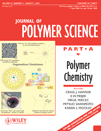Effect of prepolymer molecular weight on solid state polymerization of poly(bisphenol a carbonate) with nitrogen as a sweep fluid
Abstract
The effect of prepolymer molecular weight on the solid-state polymerization (SSP) of poly(bisphenol A carbonate) was investigated using nitrogen (N2) as a sweep fluid. Prepolymers with different number–average molecular weights, 3800 and 2400 g/mol, were synthesized using melt transesterification. SSP of the two prepolymers then was carried out at reaction temperatures in the range 120–190 °C, with a prepolymer particle size in the range 20–45 μm and a N2 flow rate of 1600 mL/min. The glass transition temperature (Tg), number–average molecular weight (Mn), and percent crystallinity were measured at various times during each SSP. The phenyl-to-phenolic end-group ratio of the prepolymers and the solid-state synthesized polymers was determined using 125.76 MHz 13C and 500.13 MHz 1H nuclear magnetic resonance (NMR) spectroscopy. At each reaction temperature, SSP of the higher-molecular-weight prepolymer (Mn = 3800 g/mol) always resulted in higher-molecular-weight polymers, compared with the polymers synthesized using the lower molecular weight prepolymer (Mn = 2400 g/mol). Both the crystallinity and the lamellar thickness of the polymers synthesized from the lower-molecular-weight prepolymer were significantly higher than for those synthesized from the higher-molecular-weight prepolymer. Higher crystallinity and lamellar thickness may lower the reaction rate by reducing chain-end mobility, effectively reducing the rate constant for the reaction of end groups. © 2008 Wiley Periodicals, Inc. J Polym Sci Part A: Polym Chem 46: 4959–4969, 2008




